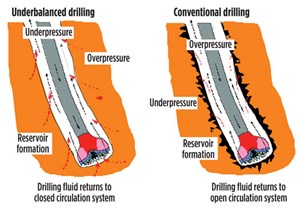What's new in exploration
Warning people about climate change is about as useful as telling a Brit to carry a brolly (umbrella) in East London. Earth began at over 3,600o F (NOAA) and has been changing every day since (climate.gov). Obfuscation by politicians (see Merriam-Webster dictionary, humans, definition 1b) to end drilling for fossil fuels might prevent us from actual knowledge of climate affecting my species’ survival. Alternatively, is cellular and Internet tech responsible for the recent decline in the earth’s magnetic field, thus allowing increased radiation onto the surface? Just asking. People on planet Earth will need oil and gas—for a long, long time, not just the next 10 years.
Is “Sci-Ence” scape-goating by those who never understood the practice? Did our leaders sleep in chemistry class? What future leader is studying STEM versus community organizing? Who can weld, work a vector or turn-to-the-right?
Exploration continues offshore Trinidad, the South China Sea, the Philippines, and others, as posted in World Oil. BOEM, et al., agreed to stop seismic exploration offshore the Atlantic U.S. However, President DJT added that if enviro is important to the Atlantic, there should be no more wind or solar platforms offshore, either. Dialogue depends on who is inaugurated on Jan. 20, 2021.
“Frac” is the 4-letter word of politics. Has demand cut service to two major companies? The U.S. rig count stalls to 300, yet the count (in normal times) should be above 1,200. We are told (EIA) that there are thousands of DUC wells worldwide, most in onshore U.S. shales. Completions should rule. Exploration-derived reservoir tech is needed before shooting casing.
If the over-washed leaders of major oil divest millions of barrels of oil and boe’s of gas, selling assets means someone else will own lots of future revenue. Such “PC” action does NOTHING to change climate, only creating an appearance of caring. Green electrical energy transition is “nearing” 30% [IEA.org] from large-cap facilities. Non-ethanol renewables for transportation use are <1% [electric, IEA, 2020, Global Energy Review/Renewables] Corn for fuel is not efficient, no matter what you call it. Small wonder, then, that oil stock futures are flailing.

Most wells have been drilled overbalanced, Fig. 1. All drilled worldwide below hydrostatic pressure, say about 5,500 ft [1676.4 m], still are. That is, drilled using mud weights in excess of natural formation pressures. Safety, fear, ignorance and/or poor training are factors. Many engineers believe that most wells from abandoned fields could have produced more, e.g., Material Balance calculations. What’s possible, if step-outs are completed at formation pressures by someone with a steady nerve and a fresh bit?
Mud balance? My experience indicates that overbalance constitutes the norm for the U.S. Gulf Coast onshore, all GOM offshore and just about any time a mud salesman comes around management. Rolex anyone? DOE funded the researching of mud issues because of recommendations from technical advisors I worked with as Deepwater manager for RPSEA. My independent O&G efforts failed to convince drillers, say budget drillers, to drill at balance, let alone underbalanced. I could have used space-age geo tech with 120% assurance of oil (Texas LBJ terminology), yet no new hydrocarbons in the mud pit.
Benefits to underbalanced, as stated in an old book, are “…increased penetration rate, improved bit life, minimize lost circulation, minimize differential sticking, reduced formation damage, earlier production, reduced stimulation requirements, improved formation evaluation, and environmental benefits…,” Gas Research Institute, Underbalanced Drilling Manual, 1997, Intro, pp. I-2, I-4. Newer publications are available, lo mismo (the same). How many drillers or toolpushers have read an underbalanced mud manual? There are not many drillers left who can “feel the bit” before looking at gauges. Is mud balance incorporated into A.I. monitoring programs? The dog house today could be an office in Houston, while the offshore crew has no idea that mud is lost and pressures are building, as in Macondo (BSEE, USCG). You won’t get support for at-balance or underbalance without a meaningful, alert team on the drill floor.
I disagree with the GTI Manual. Feeling greenish for November, I say in order to protect our environment, start cutting risk by first getting better formation evaluation. Do not bother to drill a hole if you are not willing to purchase a well. wjh

- When electric meets intelligence: Powering a new era in hydraulic fracturing (January 2024)
- Next-generation electric fracturing system improves efficiency, ESG performance (January 2024)
- What's new in exploration (November 2023)
- What's new in production (August 2023)
- Mobile electric microgrids address power demands of high-intensity fracing (July 2023)
- Organic acids offer an alternative acidizing practice for production optimization (June 2023)
- Applying ultra-deep LWD resistivity technology successfully in a SAGD operation (May 2019)
- Adoption of wireless intelligent completions advances (May 2019)
- Majors double down as takeaway crunch eases (April 2019)
- What’s new in well logging and formation evaluation (April 2019)
- Qualification of a 20,000-psi subsea BOP: A collaborative approach (February 2019)
- ConocoPhillips’ Greg Leveille sees rapid trajectory of technical advancement continuing (February 2019)


